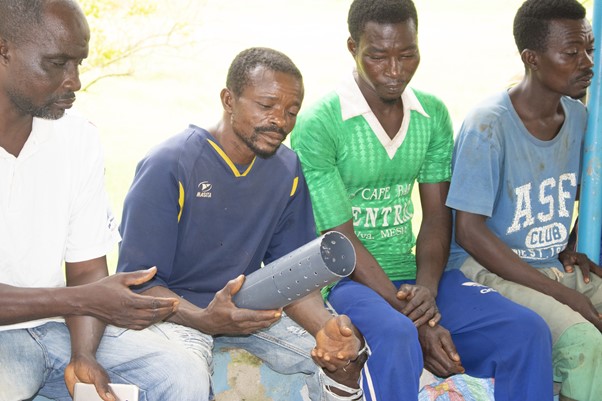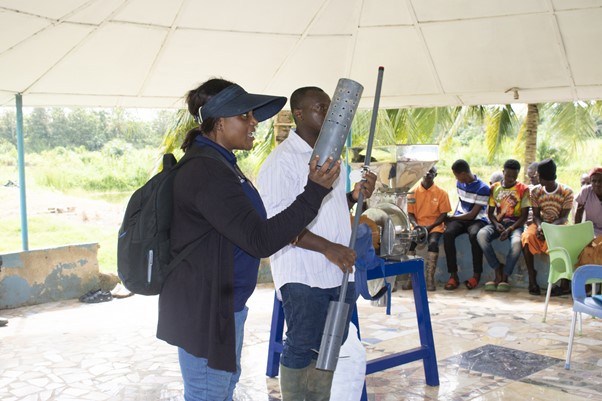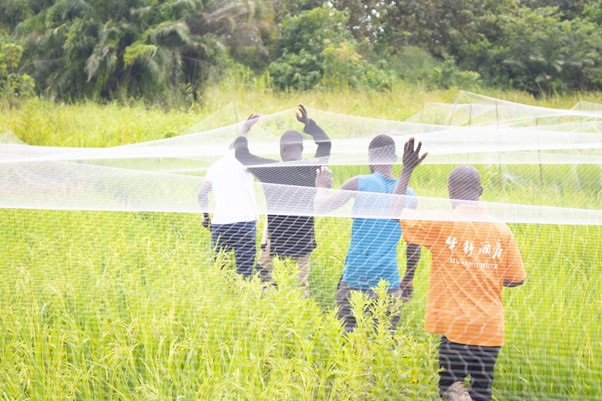MITIGATING CLIMATE CHANGE IN RICE PRODUCTION: RICE FARMERS INTRODUCED TO THE ALTERNATE WETTING AND DRYING TECHNOLOGY

Have you ever visited a Ghanaian farm during the minor season? It can be quite astonishing – fields turning dry and plants wilting. This happens because agriculture in Ghana is mostly rain-fed, and in the minor season, when rains cease, plants suffer immensely. This issue is especially true for rice farmers who use much water for cultivation. The narrative rice farmers in Ghana have gathered over the years is that the rice crop needs a lot of water to flourish. But is this perception accurate? Is an extensive water supply truly necessary for the flourishing of rice cultivation?
A Farmers’s Struggle
Madam Ama Diana, a mother of four and a farmer from Bronikrom, lamented that she chose not to cultivate rice in the minor season because she couldn’t afford the excessive stress and cost of irrigation. She stated, “Despite having a dam near my farm, the expenses associated with pumping water into my field are substantial. At least in the major season, there is rain, but in the minor season, the rains keep decreasing compared to what we have seen in the past. Considering the large amount of water I have to feed my rice farm, I decided to forego planting rice during the minor season to save myself the associated challenges and costs.“

Research and Collaboration
In response to several of such heartbreaking circumstances, the CSIR-Crops Research Institute has been actively researching water management in rice production over the past six years through research partnership with the Lancaster University under a GCRF funded project called Recirculate. When the Recirculate project folded up, the UK government further supported research in AWD through the GCRF and UKRI Innovate project to develop the technology further for farmer uptake. At the verge of scaling the AWD technology, the CSIR-Crops Research Institute has partnered with the International Water Management Institute (IWMI), to promote the technology to rice growers across the country as part of interventions under the Sustainable Intensification of Mixed Farming Project (SI-MFS).
On Friday, 3rd November 2023, the CSIR-CRI and IWMI organised a farmer field day to promote the ‘Alternate Wetting and Drying for Off-Season Rice and Fodder Production’ at Bronikrom at Ahafo-Ano South East.
Introducing AWD Technology

Dr. Patricia Yeboah, the lead scientist overseeing the project, outlined the objective of the field day, which was —to introduce the farmers to Alternate Drying and Wetting technology and its benefits. She clarified that researchers have recognized that rice farming doesn’t necessarily require too much water during its production.
Some farmers in Bronikrom had been previously introduced to the AWD technology during the project’s earlier visit to the community, where several AWD demonstration fields were established on farmers’ fields. To enhance awareness of AWD, 100 farmers were invited to inspect the demonstration fields and personally assess the physical differences of the AWD technology compared to the conventional rice cultivation methods used by farmers in and around the district.
AWD is a relatively new technology that assesses real time soil moisture for irrigation scheduling. Unlike conventional practices where farmers rely solely on the soil surface water dynamics to determine if the rice needs water or not, AWD regulates the moisture of the soil itself. It utilises simple PVC pipes inserted into the soil to monitor moisture levels as they decrease within the soil layer. This method allows for better control over water supply to the plants, enhancing resource use efficiency. AWD can reduce water usage to one-third compared to conventional methods of rice production.
AWD and Climate Change

Importantly, AWD plays a crucial role in mitigating climate impact by significantly lowering greenhouse gas emissions in rice production fields. If traditional rice farming methods contribute to a 90% emission of greenhouse gases like CH4 and methane, AWD reduces methane production in rice production by up to 70%, making it a climate mitigation technology. Dr. Amankwaa-Yeboah showed the farmers how to build their own water table monitoring devices known as the water table cylinder, using PVC pipes. She also demonstrated how the cylinders can be installed in the fields and monitored for irrigation scheduling. She stated, “We have made AWD technology so simple that anyone can learn and adopt it, regardless of educational background. If any farmer here decides, they can easily learn how to use AWD to boost their rice farming.“
Subsequently, Dr. Birhanu Zemadin Birhanu of the international Water Management Institute IWMI addressed the farmers. He mentioned that farmers always wondered when they should irrigate their fields and how to determine when the field has enough water. He emphasised that AWD provides answers to these queries. The PVC cylinders visually indicate the water levels in the soil, helping farmers determine the optimal time for irrigation. He urged them to adopt the technology for improved yields and environmental sustainability. “Using AWD in your rice production will reduce your stress, save resources, and ultimately give you a higher yield.” Dr. Birhanu expressed gratitude for their interest and attendance, further pledging that the team would return for monitoring to assess the progress with AWD adoption in farmers’ fields.
Assessing Field Demonstration

Participants were organised into three groups, each accompanied by a technician guiding them to the demonstration fields. These fields showcased the application of AWD alongside conventional methods used by farmers. Uniform fertiliser dosage, improved seed varieties, and good agronomic practices were maintained across all demonstration fields, with the only key distinction being water management and irrigation scheduling.
Farmers were tasked with selecting the field they most preferred, either AWD or conventional, based on physical appearance criteria such as plant height, flowering, tillering, colour, and firmness of plant stand.
Farmers’ Feedback

Surprisingly, none of the farmers selected the fields where conventional methods were used. Their reasons were that the AWD demonstration plots not only looked vigorous and green but also exhibited healthy tillering and good grain filling.
Speaking to Mr. Kwabena Kyie Baffour, a farmer who attended the field day, he said, “We visited rice bonds with AWD and others without AWD; the difference is as clear as day and night. I’m interested in this technology, and the rice in the AWD demonstration field looks healthy. It’s firmer, greener, has fewer weeds, and has tillered well.“
Some of the PVC water monitoring cylinders were distributed to farmers who showed eagerness to adopt the AWD technology. By adopting AWD, rice farmers like Madam Ama Diana, who chooses not to plant during the minor season due to irrigation woes, now have the opportunity to grow rice since the AWD requires less water than she is used to.
Farmers also received education on sound agronomic practices, including the importance of seed nursing and transplanting in rows following recommended planting . Before the closing prayer, the farmers were provided with the contact information of scientists from CSIR-CRI, encouraging them to reach out in case they encountered any challenges while implementing the alternate wetting and drying technology.
Authors: Patricia Konadu Mensah, Dr. Patricia Amankwah-Yeboah, Dr. Stephen Yeboah, Bernard Sakyiamah, Enoch Bobie Agyemang
